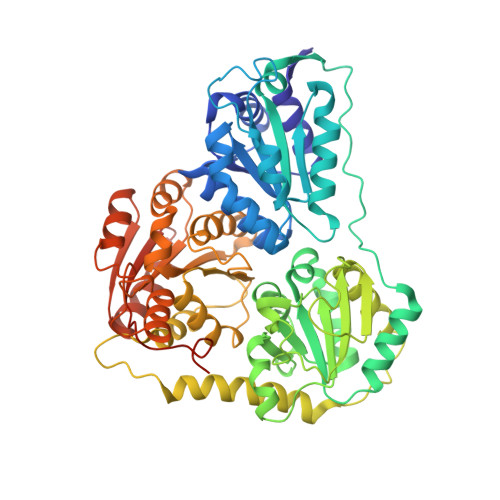Probing the active center of benzaldehyde lyase with substitutions and the pseudosubstrate analogue benzoylphosphonic acid methyl ester
Brandt, G.S., Nemeria, N., Chakraborty, S., McLeish, M.J., Yep, A., Kenyon, G.L., Petsko, G.A., Jordan, F., Ringe, D.(2008) Biochemistry 47: 7734-7743
- PubMed: 18570438
- DOI: https://doi.org/10.1021/bi8004413
- Primary Citation of Related Structures:
3D7K - PubMed Abstract:
Benzaldehyde lyase (BAL) catalyzes the reversible cleavage of ( R)-benzoin to benzaldehyde utilizing thiamin diphosphate and Mg (2+) as cofactors. The enzyme is important for the chemoenzymatic synthesis of a wide range of compounds via its carboligation reaction mechanism. In addition to its principal functions, BAL can slowly decarboxylate aromatic amino acids such as benzoylformic acid. It is also intriguing mechanistically due to the paucity of acid-base residues at the active center that can participate in proton transfer steps thought to be necessary for these types of reactions. Here methyl benzoylphosphonate, an excellent electrostatic analogue of benzoylformic acid, is used to probe the mechanism of benzaldehyde lyase. The structure of benzaldehyde lyase in its covalent complex with methyl benzoylphosphonate was determined to 2.49 A (Protein Data Bank entry 3D7K ) and represents the first structure of this enzyme with a compound bound in the active site. No large structural reorganization was detected compared to the complex of the enzyme with thiamin diphosphate. The configuration of the predecarboxylation thiamin-bound intermediate was clarified by the structure. Both spectroscopic and X-ray structural studies are consistent with inhibition resulting from the binding of MBP to the thiamin diphosphate in the active centers. We also delineated the role of His29 (the sole potential acid-base catalyst in the active site other than the highly conserved Glu50) and Trp163 in cofactor activation and catalysis by benzaldehyde lyase.
- Department of Biochemistry, Brandeis University, Waltham, Massachusetts 02454, USA.
Organizational Affiliation:


















